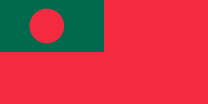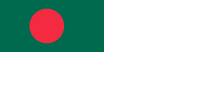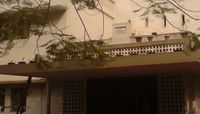Flag of Bangladesh
 |
|
| Use | National flag |
|---|---|
| Proportion | 3:5 |
| Adopted | 17 January 1972 |
| Design | A red disc on a green field. |
| Designed by | Quamrul Hassan |



.svg.png)
The national flag of Bangladesh (Bengali: বাংলাদেশের জাতীয় পতাকা) was adopted officially on 17 January 1972. It is based on a similar flag used during the Bangladesh Liberation War of 1971. The map was later deleted from the flag by the order of General Abul Manzur, most likely to simplify the design. A red disc is on top of the green field, offset slightly toward the hoist so that it appears centred when the flag is flying. The red disc represents the sun rising over Bengal, and also the blood of those who died for the independence of Bangladesh. The green field stands for the lushness of the land of Bangladesh. The red disc is a socialist symbol of the rising Sun of independence after the dark night of a blood-drenched struggle against Pakistan.[1]
The civil ensign and naval ensign place the national flag in the canton of a red or white field, respectively.
Contents |
Origin

The original flag was designed by painter Quamrul Hassan. On 2 March 1971, the initial version of the flag was hoisted in Bangladesh for the first time at the Dhaka University.[2] As the Vice President of Dhaka University Students' Union (DUCSU), student leader A. S. M. Abdur Rab hoisted the flag. On the declaration of Independence on 26 March 1971, Sheikh Mujibur Rahman flew the flag in his residence.
The flag was conceived so as to exclude the crescent and the star considered as symbols of West Pakistan. According to Flags of the World, the green used in the flag does not represent the traditional colours of Islam, contrary to some western sources (such as the CIA World Fact Book)[1][3]. Rather, the green colour was chosen to represent the lushness of the natural landscape of Bangladesh. The current flag resembles the flag of Japan with the background a different colour.
The map was removed from the flag in 1972. One reason given was the difficulty rendering the map correctly on both sides of the flag.[1]
Official specifications
According to Bangladesh Government specifications[4], following is the specification of the national flag:
-
- The flag will be in bottle green and rectangular in size in the proportion of 10:6, with a red circle in near middle.
- The red circle will have a radius of one-fifth of the length of the flag. Its centre will be placed on the intersecting point of the perpendicular drawn from the nine-twentieth part of the length of the flag, and the horizontal line drawn through the middle of its width.
- The green base of the flag will be of Procion Brilliant Green H-2RS 50 parts per 1000. The red circular part will be of Procion Brilliant Orange H-2RS 60 parts per 1000.
- Depending on the size of the building the flag sizes will be 10 × 6 ft (3.0 × 1.8 m); 5 × 3 ft (1.5 × 0.91 m); 2.5 × 1.5 ft (760 × 460 mm). The size of the flag for car is 12.5 × 7.5 in (320 × 190 mm), and the size of the table flag for bilateral conferences is 10 × 6 in (250 × 150 mm).
Colour
(a) The green base of the flag will be of Procion Brilliant Green H-2RS 50 parts per 1000. (b) The red circular part will be of Procion Brilliant Orange H-2RS 60 parts per 1000.[5]
References
- ↑ 1.0 1.1 1.2 Flag of Bangladesh, Flags of the World.
- ↑ Glassie, Henry and Mahmud, Feroz.2008.Living Traditions. Cultural Survey of Bangladesh Series-II. Asiatic Society of Bangladesh. Dhaka. p.580
- ↑ "Lonely Planet: Bangladesh", 4th Edition, Lonely Planet Publications,(December 2000), ISBN 0-86442-667-4.
- ↑ PEOPLE'S REPUBLIC OF BANGLADESH FLAG RULES, 1972 (Revised up to 2005), Government of Bangladesh, Cabinet Division
- ↑ Bangladesh Flag Rules, 1972 (Revised up to July 2005)
|
||||||||||||||
|
||||||||
External links
- Bangladesh at Flags of the World
- Entry on National Flag, Banglapedia.